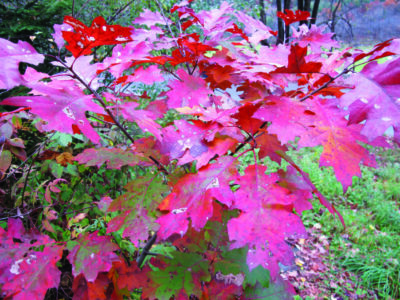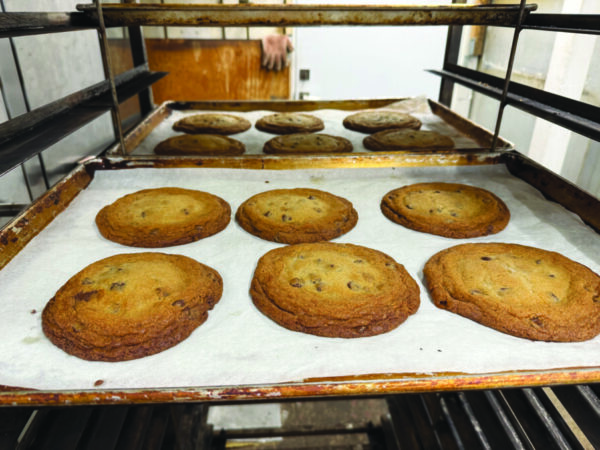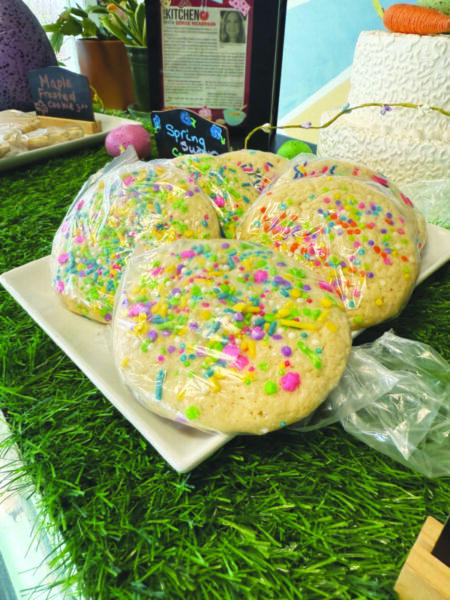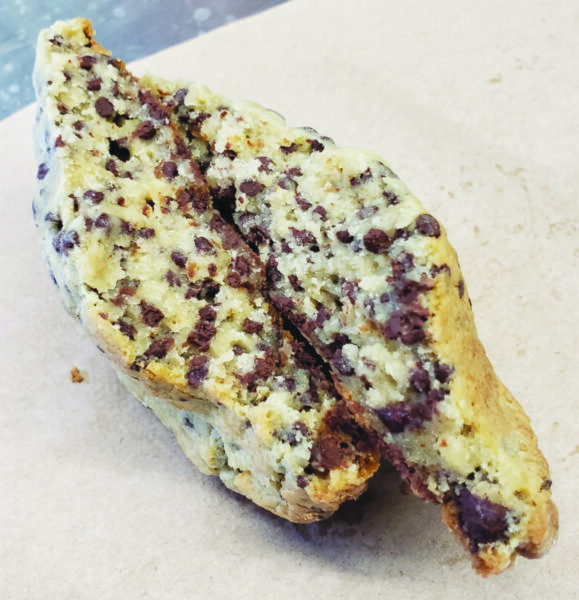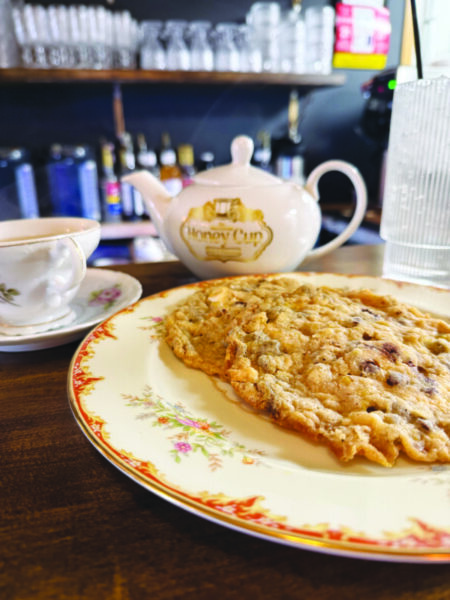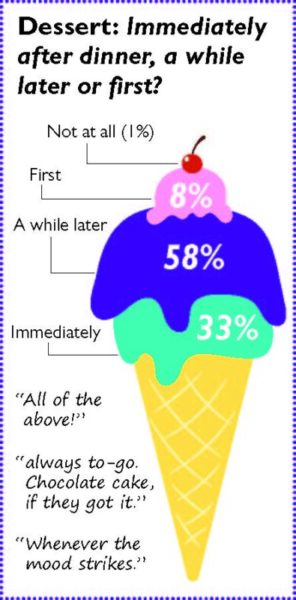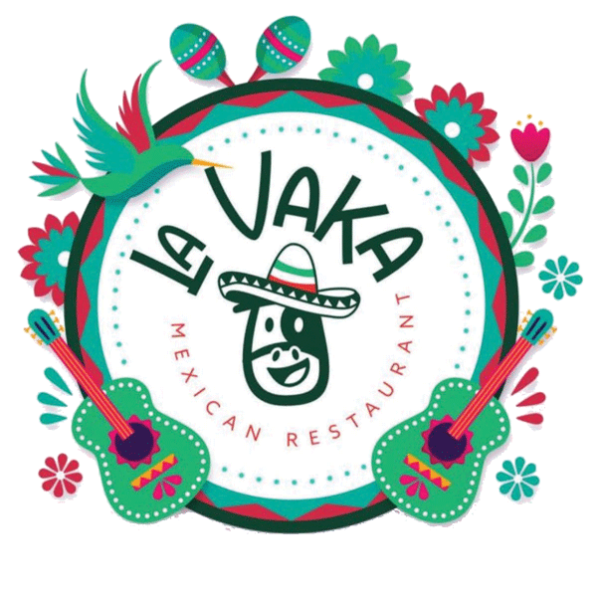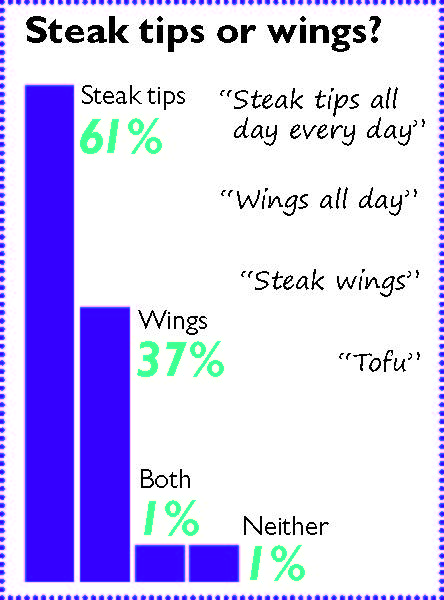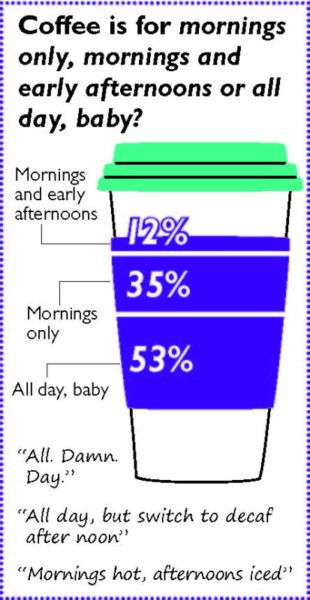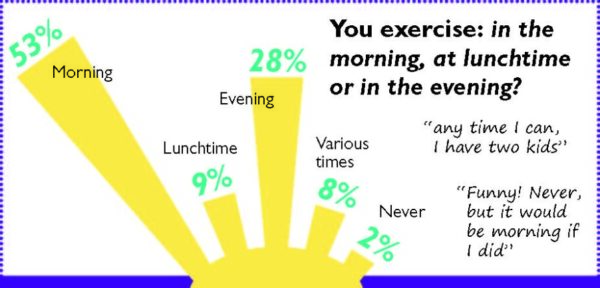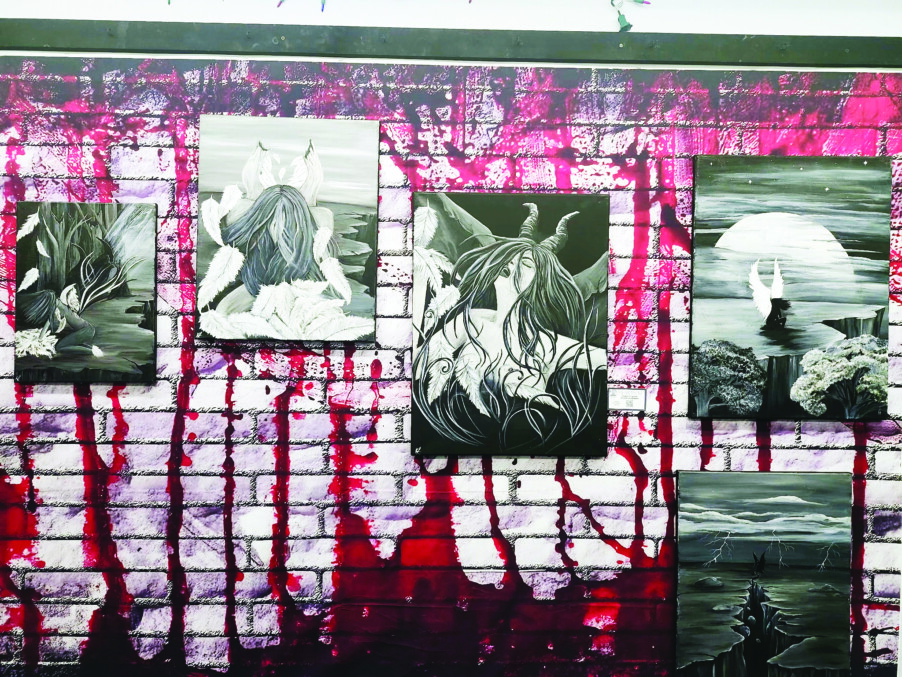The calendar says spring begins on March 20. Whether this year’s spring is hot, cold or just muddy, here are some ways to have fun and celebrate the season from now until the summer vibes kick in Memorial Day weekend. The information here is from the presenting events’ websites and social media; did we miss some spring fun? Let us know at adiaz@hippopress.com.
1. Who needs some laughs? There are many opportunities to check out Queen City Improv in the coming months. They have free open sessions at the Unitarian Universalist Church of Manchester (669 Union St. in Manchester) on Thursdays, March 20, April 17 and May 15, at 6 p.m. Register on their website. Or catch them at the BNH Stage in Concord on Friday, April 4, at 8 p.m., or at shows at Stark Brewing Co. (500 Commercial St. in Manchester) on Mondays, April 7 or May 5, at 7 p.m. See queencityimprov.com.
2. You can still catch the last two menus of burgers at Burgerama at the Bedford Village Inn (2 Olde Bedford Road in Bedford; bedfordvillageinn.com). Through Saturday, March 22, it’s Asian week (the menu includes Bahn Mi Sliders). Sunday, March 23, through Saturday, March 29, it’s BVI Favorites with a BVI Big Double Burger, a French Dip Burger and N’Duja Pizza Sliders).
3. Kathleen D. Bailey will discuss her book A History Lover’s Guide to New Hampshireon Thursday, March 20, at 6:30 p.m. at Gibson’s Bookstore (45 S. Main St. in Concord; gibsonsbookstore.com). Other authors scheduled to appear at Gibson’s include Stephen Monier with his book No One Has to Die: Inside the Longest Armed Standoff in the History of the U.S. Marshals (March 27), John Scalzi (March 30), Andru Volinsky (April 2), Susie Spikol (April 12), Christopher Golden (May 6) and more.
4. The exhibit “Currents” continues at Pillar Gallery + Projects (205 N. State St. in Concord; pillargalleryprojects.com) through April 2. The gallery is open Fridays, Sundays and Tuesdays, 3 to 7 p.m. Gallery co-founder and owner Fallon Rae spoke about the show to Zachary Lewis on page 6 of the Feb. 27 issue of the Hippo; find it in the digital library at hippopress.com.
5. The art gallery Outer Space (35 Pleasant St. in Concord; outerspacearts.xyz; open Saturdays, 11 a.m. to 5 p.m.) continues its recently opened “Worlds,” an exhibit of the works of Julian Kent and Emma Kohlmann.
6. Take the kids to watch the kids of the Bedford Youth Performing Company (bypc.org) perform the musical Bye Bye Birdieon Friday, March 21, and Saturday, March 22, at the Derryfield School theater in Manchester. Find the link to purchase tickets via BYPC’s Facebook page.
7. The Peacock Players present their second weekend of their Spring Youth Mainstage ProductionShrek The Musical Jr.with shows Friday, March 21, at 7 p.m. and Saturday, March 22, and Sunday, March 23, at 2 p.m. at Janice B. Streeter Theatre, 14 Court St. in Nashua. Tickets cost $15 to $18 for adults, $12 to $15 for students and seniors.
8. The Pinkerton Players will present the Elvis-y,Twelfth Night-yAll Shook Up at Stockbridge Theatre in Derry Friday, March 21, and Saturday, March 22, at 7 p.m. and Sunday, March 23, at 2 p.m. Tickets cost $15. See stockbridgetheatre.showare.com.
9. Catch Dueling Pianos twice at the Tupelo Music Hall (10 A St. in Derry; tupelomusichall.com) before Memorial Day on Friday, March 21, at 8 p.m. and Saturday, April 19, at 8 p.m. Tickets cost $22.
10. Get some insight into how our feathered neighbors weather the season change with a Birding Outing at the McLane Center (84 Silk Road in Concord; nhaudubon.org) on Saturday, March 22, at 8 a.m. The event is free but register online. The NH Audubon has several Birding Outings on the schedule as well as art exhibits and other events; see nhaudubon.org.
11. Concord-based Art Alley Cats (artalleycats.com) and DIY Craft & Thrift (diycraftandthrift.com) will present the art exhibit “Revive, Renew, Reconnect” at Kimball Jenkins (266 N. Main St. in Concord; kimballjenkins.com) through Wednesday, April 16, with a special showcase on Saturday, March 22, from 10 a.m. to 3 p.m. and an opening reception on Saturday, March 29, from 5 to 7 p.m. “Over 15 local artists of varying backgrounds and artistic styles will be represented in this mixed media exhibition,” according to a post on Art Alley Cats’ Instagram. Also on March 22 from 10 a.m. to 3 p.m. at Kimball Jenkins in Concord, catch the Concord Arts Market Winter Arts Market & Activities. The event will feature Concord Arts Market vendors in the Carriage House along with demonstrations and other activities. See concordartsmarket.org.
12. Root for the lacrosse teams at Southern New Hampshire University. The men’s team’s next home game is scheduled for Saturday, March 22, at 11 a.m. at Mark A. Ouellette Stadium on the SNHU campus (the stadium is on Victory Lane in Hooksett) versus Saint Michael’s College. The women’s next home game is Saturday, March 22, at 2 p.m. versus University of New Haven. Regular season games are free to attend; see snhupenmen.com for the full schedule.
13. Cheer Nashua’s Rivier University Raiders men’s and women’s lacrosse teams. The next home game for the men’s lacrosse team will be Saturday, March 22, at 2 p.m., on Joanne Merrill Field at Linda Robinson Pavilion in Nashua against New England College. The women’s team’s next home game is Saturday, March 22, at 11 a.m. when they face Lasell University. See rivierathletics.com.
14. Bookery Manchester (844 Elm St. in Manchester; bookerymht.com) will feature author pop-ups on Saturday, March 22, with Dawn Aurora Hunt, who has books as well as her recent A Kitchen Witch’s Culinary Oracle, 11 a.m. to 2 p.m., and Jezmina Von Thiele, Secrets of Romani Fortune Telling, 2:30 to 5:30 p.m. Other authors scheduled to be at Bookery include Tabatha D’Agata (The Old Scarecrow, March 29), Eskor David Johnson (Pay as You Go, March 29), Joshua Bresslin and Ian M. Rogers (April 5) and Leah Dearborn (Grenier Air Base, April 18).
15. Programming at the New Hampshire Historical Society (30 Park St. in Concord; nhhistory.org) includes Family Fun Day on Saturday, March 22, from 2 to 4 p.m. This free event features games, crafts, storytelling, tours of the exhibits and more. The event is geared to families with kids ages 6 to 10 but all ages are welcome, the website said.
16. Recycled Percussion celebrates 30 years of performances: “On March 24, 1995, three high school kids took the stage at Goffstown High School to perform a 4-minute drumming routine at a talent show. Little did anyone know that it would become a worldwide sensation over the next 30 years. With over 8,000 performances in over 40 countries, Recycled Percussion has become a household name and created the best live show experiences for families worldwide,” according to a description on the website for the Dana Center for the Humanities at Saint Anselm College in Manchester, where Recycled Percussion will perform two shows on Saturday, March 22, at 3 & 7 p.m. Tickets cost $50 (plus fees) or $100 for a VIP experience. See tickets.anselm.edu. Recycled Percussion will also be at the Flying Monkey in Plymouth (flyingmonkeynh.com) on March 29 at 3 and 7 p.m.
17. Chopin Piano Concerto the winter concert of the Nashua Chamber Orchestra takes place Saturday, March 22, at 7:30 p.m. at Nashua Community College and Sunday, March 23, at 3 p.m. at Milford Town Hall. See nco-music.org for tickets.
18. The Tupelo Music Hall (10 A St. in Derry; tupelomusichall.com) has a packed music schedule this spring, including Pete Best & the Pete Best Band on Saturday, March 22, at 8 p.m. Tickets cost $50 to $55. Other shows on the schedule include Walter Trout (March 27), Ally the Piper (March 28), Young Dubliners (March 30), The Record Company (April 13), John Oates (April 27), Gary Hoey (May 9) and more.
19. Catch Rivier University’s Raiders men’s baseball at home next on Tuesday, April 1, at 3:30 p.m., when they play Dean College at Holman Stadium (67 Amherst St. in Nashua). The women’s softball team plays at Raider Diamond and their next game will be a doubleheader against Lesley University on Sunday, March 23, at noon and 2 p.m. See rivierathletics.com.
20. The New Hampshire Jewish Film Festival runs Sunday, March 23, through Friday, April 11, with a line-up of in-theater and virtual screenings. An opening day lunch reception will be held at noon at the Spotlight Room in Manchester followed by a screening of the film Shari & Lamb Chop at the Rex Theatre in Manchester. Screenings continue at locations in Manchester, Merrimack and Red River Theatres in Concord (as well as in Hanover, Portsmouth and Keene) followed by a virtual screening bonus week April 6 (the day of the final in-theater screenings) through April 11. See nhjewishfilmfestival.com for trailers of most of the film as well as a schedule for screenings, both virtual and in theaters, as well as ticket packages that range from individual films to all access.
21. Big Bad Voodoo Daddy comes to the Flying Monkey (39 S. Main St. in Plymouth; flyingmonkeynh.com) on Sunday, March 23, at 7:30 p.m. Tickets cost $45 to $75. Other shows at the Flying Monkey in the next few months include Redneck Castaway Band and Red Solo Cup (March 21), Duane Betts and Palmetto Motel (April 13), RDMTION (May 2), Mamma Mania (May 16) and more. The Flying Monkey also screens movies most Wednesdays (family movie night) and Thursdays at 6 p.m.
22. Studio 550 Art Center (550 Elm St. in Manchester; 550arts.com) will hold a Spring Cleaning Pottery Sale Monday, March 24, through Saturday, March 29, noon to 8 p.m. The pottery will include discount pottery made by members and staff, donated pottery with proceeds benefiting the Art for All Fund, and $1 abandoned workshop pottery, the website said.
23. Watch the Southern New Hampshire University Penmen baseball team play the Saint Anselm Hawks at Penmen Field on Wednesday, April 2, at 3 p.m. The women’s softball team will play a doubleheader against American International College at home on Wednesday, March 26, with games at 2 and 4 p.m. p.m. at the SNHU Softball Field (on Eastman Drive). See snhupenmen.com for more games and details.
24. Cheer on the Saint Anselm College Hawks baseball team, whose upcoming home game is Wednesday, March 26, at 2 p.m. versus Southern New Hampshire University at Sullivan Park on the Saint Anselm College campus in Manchester. The women’s softball team will play their next home games on Friday, April 4, at 2 and 4 p.m. against Franklin Pierce at the South Athletic Fields on the Saint Anselm College campus. See saintanselmhawks.com.
25. Get some Saint Anselm College Hawks lacrosse. The women’s team’s next home game is Wednesday, March 26, at 7 p.m. against Saint Michael’s College. The men’s team will play its next home game on Friday, March 28, at 4 p.m. versus Assumption. Both games take place at Grappone Stadium on the Saint Anselm College campus in Manchester. See saintanselmhawks.com.
26. Get serious laughs when comedian Leslie Jones comes to the Nashua Center for the Arts (201 Main St. in Nashua; nashuacenterforthearts.com) on Thursday, March 27, at 7:30 p.m. Tickets start at $49. Other shows on the Nashua Center for the Arts schedule include Chazz Palminteri — A Bronx Tale Live ( March 29); Marc Cohn (March 30); the Wise Guys of Comedy with Ace Aceto, Frank Santorelli, and Brad Mastrangelo (April 12); Ari Shapiro: Thank You for Listening (May 9) and more.
27. Comedian Bob Marley has a packed schedule of New Hampshire dates over the next few months, starting with Thursday, March 27, at 7:30 p.m. at the Flying Monkey (39 S. Main St. in Plymouth; flyingmonkeynh.com), where tickets cost $39.50. Additional shows include March 28-29 at the Music Hall in Portsmouth and May 16-18 at the Palace Theatre in Manchester, as well as shows across New Hampshire and New England. See bmarley.com.
28. Fans of “the Ton” can put on their Regency best for the Bridgerton Dinner Party with String Quartet on Friday, March 28, at 6:30 p.m. at LaBelle Winery (345 Route 101 in Amherst; labellewinery.com). The night will feature a four-course dinner with wine pairings and music by Yaeko Miranda string quartet, the website said. The cost is $89 per person. LaBelle also offers music, comedy, craft workshops and more this spring at its Amherst and Derry locations, as well as two murder mystery dinner parties (March 29 and April 26).
29. The Majestic Academy of Dramatic Arts youth and teens presents Matilda The Musical Jr. Friday, March 28, at 7 p.m.; Saturday, March 29, at 2 and 7 p.m., and Sunday, March 30, at 2 p.m. at the Derry Opera House (29 W. Broadway in Derry; majestictheatre.net). Tickets cost $12 to $16.
30. The Anselmian Abbey Players present Guys and Dolls Friday, March 28, through Sunday, March 30, and Thursday, April 3, through Saturday, April 5, at the Dana Center at Saint Anselm College in Manchester (tickets.anselm.edu). All shows are at 7:30 p.m. except Sunday, March 30, at 2 p.m. Tickets cost $20 for adults, $17 for seniors and non-Saint Anselm students.
31. The Capital City Craft Festival runs Saturday, March 29, 10 a.m. to 5 p.m., and Sunday, March 30, 10 a.m. to 4 p.m., at the Everett Arena (15 Loudon Road in Concord). Tickets cost $10, children under 14 get in free. See castleberryfairs.com/capital-city-craft-festival-2025.
32. “Hollywood’s First Sequel” is how Jeff Rapsis has labeled his two-part screening on Saturday, March 29, and Sunday, March 30 at 2 p.m. at Wilton Town Hall Theatre on Main Street in Wilton. Part I on Saturday will feature 1920’s The Mark of Zorro starring Douglas Fairbanks Sr. Part II on Sunday will feature 1925’s Don Q, Son of Zorro, also starring Fairbanks. Both movies are silent films presented with live musical accompaniment by Rapsis, and admission to each film is free, with a $10 donation suggested. See silentfilmlivemusic.blogspot.com.
33. Ballet Misha will present Cinderella, performed by Ballet Misha’s professional adult dancers, apprentice company and students from Dimensions in Dance, on Saturday, March 29, at 2 and 6 p.m. at the Concord City Auditorium (2 Prince St. in Concord). Tickets cost $31.60 for adults, $21.40 for children. See balletmisha.com.
34. Symphony NH with guest conductor Herb Smith will present Hollywood Hits featuring the music of James Bond, Lawrence of Arabia, Rocky, The Pink Panther, The Magnificent Seven and more. Hear the sounds of iconic scores on Saturday, March 29, at 7:30 p.m. at the Stockbridge Theatre in Derry. Tickets start at $40. Hollywood Hits will also be presented the following night at the Capitol Center for the Arts in Concord. Symphony NH has three more concerts on the schedule this season: “It’s All Overtures” on April 19 at the Nashua Center for the Arts, “Rhapsody in Blue” on May 10 at the Cap Center and “Illuminated Ensembles — Chamber Favorites” on May 18 at BNH Stage in Concord. See symphonynh.org and check out Michael Witthaus’ story about the symphony’s plans this season and beyond in the March 6 issue of the Hippo, which is available in our digital library at hippopress.com.
35. The Manchester St. Patrick’s Parade steps off at noon on Sunday, March 30, running down Elm Street from Salmon to Central. Join in the fun by running in the Shamrock Shuffle at 11 a.m. (a kids’ fun run starts at 10:30 a.m.). See millenniumrunning.com/shamrock for details on the 2-mile run/walk and visit saintpatsnh.com for more on the parade.
36. Southern New Hampshire Youth Ballet will present Snow White on Sunday, March 30, with shows at 1 and 4 p.m. The role of Snow White will be shared by 16-year-old dancers Madison Cleland of Bedford and Hadley Hornor of Amherst, and the cast is rounded out by Southern NH Youth Ballet dancers from across the southern New Hampshire region as well as guest artist Nate Duszny as Prince Charming. Tickets for the show at the Palace Theatre in Manchester cost $24-$29 and for an additional $20 ballet-goers can have tea with Snow White and friends 45 minutes before each show. See snhdt.org.
37. Author Anna Von Mertens will discuss her book Attention Is Discovery: The Life and Legacy of Astronomer Henrietta Leavitt at the McAuliffe-Shepard Discovery Center (2 Institute Drive in Concord; starhop.com) on Sunday, March 30. Tickets to a show at 3 p.m. in the center’s planetarium cost $7 (in addition to general admission which costs $10 to $13 depending on age). A Discovery After Dark event, which begins after the center’s usual 10:30 a.m.-to-4 p.m. hours, starts at 4:30 p.m. and includes a talk, a member Q&A, a guided art activity and book signing, the website says. Tickets cost $30 for adults, $25 for seniors, $15 for ages 13 to college and $10 for children.
38. Hispanic Flamenco Ballet will come to the Concord City Auditorium (2 Prince St. in Concord) on Tuesday, April 1, at 10 and 11 a.m. Tickets cost $19 to $33 and are available by calling 305-420-6622. See flamencoballet.com for more on the company.
39. Spend an evening with David Sedaris on Tuesday, April 1, at 8 p.m. at the Tupelo Music Hall (10 A St. in Derry; tupelomusichall.com). Tickets cost $58.
40. Catch the NH Ukeladies at a free presentation as part of the Walker Lecture series at the Concord City Auditorium (2 Prince St. in Concord) on Wednesday, April 2, at 7:30 p.m. See theaudi.org/events.
41. The music series at The Flying Goose Brew Pub and Grille (40 Andover Road in New London; flyinggoose.com) continues with shows in March and April through April 24 with Vance Gilbert. On Thursday, April 3, at 7:30 p.m. catch Lonesome Ace String Band and their Americana/bluegrass/folk. Tickets cost $25.
42. Curious George will visit for a story time at the Children’s Museum of New Hampshire (6 Washington St. in Dover; childrens-museum.org) on Friday, April 4, and Saturday, April 5, at 10 a.m. and 2 p.m. on both days. The visits are part of the museum’s Books Alive! programming and are included with admission, which costs $14.50 for everyone over 12 months and $12.50 for 65+. The museum offers sessions from 9 a.m. to noon or 1 to 4 p.m. on those days. Advanced ticket registrations are recommended.
43. Try samples and check out locally made items at the Made in NH Expo on Friday, April 4, from 1 to 7 p.m.; Saturday, April 5, from 10 a.m. to 5 p.m., and Sunday, April 6, from 10 a.m. to 4 p.m. at the DoubleTree by Hilton Manchester Downtown Hotel. Tickets cost $8 for adults and $7 for 65+; children under 14 get in free. See businessnhmagazine.com/events/made-in-nh-expo.
44. Time to play ball! Opening night for the New Hampshire Fisher Cats at Northeast Delta Dental Stadium in downtown Manchester is Friday, April 4, with their 6:35 p.m. game against the Binghamton Rumble Ponies. This season-opening stretch of games continues Saturday, April 5, at 4:05 p.m. and Sunday, April 6, at 1:35 p.m. The next stretch of games begins Tuesday, April 15, at 6:35 p.m. versus the Harrisburg Senators. See milb.com/new-hampshire for the game schedule, tickets and promotions.
45. Dance your cares away! Jim Henson’s Fraggle Rock: Back to the Rock Live comes to the Capitol Center for the Arts’ Chubb Theatre (44 S. Main St. in Concord; ccanh.com) on Friday, April. 4, at 7:30 p.m. The show features walk-around versions of the Fraggles and puppet-sized Dozers, according to the website. Tickets start at $46.75 and a VIP option includes an opportunity to get a photo with the Fraggles for an additional $30. Other Cap Center events include comedian Whitney Cummings (March 22), comedian Nikki Glaser (March 26), The Magnetic Fields 69 Love Songs 25th anniversary Day 1 (April 8) and Day 2 (April 9), Paula Pondstone (April 11), Tracy Morgan (April 12), Lyle Lovett (April 27) and more.
46. Catch the Palace Theatre’s Short Play Festival at the Rex Theatre (23 Amherst St. in Manchester; palacetheatre.org) on Friday, April 4, and Saturday, April 5. The show starts at 7:30 p.m. each night, featuring eight new plays a night, and tickets cost $24. Other Rex offerings include comedy (Ladies of Boston Comedy on April 11) and music (Britain’s Finest Beatles Tribute on May 10).
47. Meet comic book creators Jim Steranko, Donny Cates, David Michelinie, Jim Shooter, Al Milgrom, Mike Royer, Chris Campana and more at the Little Giant Comics “Old School” Comics Show on Saturday, April 5, at the Everett Arena in Concord. Doors open at 10 a.m. and tickets cost $15 in advance, $20 at the door. For $50, a VIP ticket includes 9 a.m. entry, a swag bag and more. See oldschoolcomicshow.com.
48. The Derry AuthorFest takes place Saturday, April 5, from 10 a.m. to 4 p.m. at the Derry Public Library (64 E. Broadway in Derry) and features authors including keynote speaker Laura Knoy, Gina Perry speaking about picture books, Terry Farish and Sara Lesley Arnold and Sarah Lamagna as well as an all-day book sale hosted by Gibson’s. See derryauthorfest.wordpress.com to register. That’s not the only lit fest in the state today: The Exeter Lit Fest will take place at Exeter Town Hall on Saturday, April 5, and feature author talks starting at 11 a.m. as well as other community activities. See exeterlitfest.com.
49. It’s egg hunt season and Charmingfare Farm in Candia kicks off the fun early with its Egg-citing Egg Hunt Saturdays and Sundays, April 5 through April 20 (Easter Sunday). Kids between the ages of 2 and 12 can hunt for a dozen eggs in Grandpa’s Barn, the website said. The event will also include an opportunity to meet the Easter bunny, visit farm animals (including new spring babies) and more, according to the website. Time slots between 10 a.m. and 3 p.m. are available on those days. Admission costs $29 per person.
50. Springfest! will take place at the Saint Anselm College Sullivan Arena Saturday, April 5, from 10 a.m. to 4 p.m. The day will feature vendors, a kid zone, food concessions and more. Admission costs $5 for adults, ans is free for kids 12 and under. See goffstowncitizens.org.
51. Jeremih will perform Saturday, April 5, at 7:30 p.m. at SNHU Arena (555 Elm St. in Manchester; snhuarena.com). Tickets cost $40. Also at SNHU Arena is comedian/puppeteer Jeff Dunham (March 21).
52. Get weekly comedy shows from Headliners Comedy Club at its Doubletree by Hilton Manchester Downtown location on Elm Street and at Chunky’s Cinema Pub on Huse Road and elsewhere. On Saturday, April 5, at 8:30 p.m. catch Lenny Clarke and Friends at the DoubleTree in Manchester. See headlinersnh.com.
53. Your little royalty can enjoy a Royal Princess Breakfast on Sunday, April 6, at 9:30 a.m. at the Derryfield Restaurant (625 Mammoth Road in Manchester; thederryfield.com). Tickets cost $55 for adults, $45 for children. The day will feature breakfast, games, costumed princesses, stories and more.
54. Meet superheroes and villains, get Jedi training, discover new authors and so much more at Kids Con New England, which moves to the Sheraton Nashua (11 Tara Blvd.) this year and will be held on Sunday, April 6, from 10 a.m. to 4 p.m. Tickets cost $16 for adults and kids 5 years old and up. Discounts for a family of four, military and seniors; kids under 5 get in for free. See kidsconne.square.site for tickets and a list of authors, artists and others slated to attend.
55. See 2016’s Illumination Animation movie Sing(PG) on the big screen at Nashua Center for the Arts (201 Main St. in Nashua; nashuacenterforthearts.com) on Sunday, April 6, at 2 p.m. Tickets cost $10.
56. The Concord Community Concert Association will present the Klezmer Conservatory Band at the Concord City Auditorium (2 Prince St. in Concord) on Sunday, April 6, at 7:30 p.m. Tickets cost $20 at the door (door opens at 6 p.m.) or $23 online at ccca-audi.org.
57. It’s Free Cone Day! Ben & Jerry’s annual ice cream scoop give-away is Tuesday, April 8, from noon to 8 p.m. Head to the Ben & Jerry’s at 940 Elm St. in Manchester. See benjerry.com/scoop-shops/free-cone-day.
58. New Hampshire cartoonist Marek Bennett, author of historical graphic novels about Freeman Colby, a New Hampshire teacher who fought in the Civil War, will present “Rally Round the Flag: The American Civil War Through Folksong,” an overview of that period through the music of the time at Rodgers Memorial Library (194 Derry Road in Hudson; rodgerslibrary.org) on Wednesday, April 9, at 6:30 p.m. Find more New Hampshire Humanities programming in the coming months all over the state and virtually at nhhumanities.org.Learn more about Bennett at marekbennett.com.
59. Hatbox Theatre (hatboxnh.com) carries on with events at locations including Kimball Jenkins (266 N. Main St. in Concord). Catch Andrew Pinard Discovering Magic on Wednesday, April 9, and Wednesday, May 14, at 7:30 p.m. Tickets cost $25 for adults, $22 for students and seniors. Hatbox will also present An Evening Wasted (With Tom Lehrer’s Music) April 12-13 and April 18-20 in the lobby of the Concord City Auditorium (2 Prince St. in Concord). The shows will be at 7:30 p.m. on Fridays and Saturdays and 2 p.m. on Sundays.
60. The Walker Lecture Series presents “Before They Could Speak: Laurel & Hardy in the Silent Film Era,” which features Stan Laurel and Oliver Hardy silent films including Two Tars (1928), The Finishing Touch (1928) and You’re Darn Tootin’ (1928) on Wednesday, April 9, at 7:30 p.m. at the Concord City Auditorium (2 Prince St.). See silentfilmlivemusic.blogspot.com for more on this and other presentations of silent films with live music by Jeff Rapsis this spring.
61. Joining the recently opened “Ann Agee: Madonna of the Girl Child,” “Nicolas Party and Surrealism: An Artist’s Take on the Movement” will open at the Currier Museum of Art (150 Ash St. in Manchester; currier.org) Thursday, April 10, through Monday, Sept. 1. “In celebration of the 100th anniversary of the Surrealist Manifesto (1924), Nicolas Party and Surrealism: An Artist’s Take on the Movement explores the lasting influence of Surrealism through the work of contemporary artist Nicolas Party,” according to the website.
62. LaBelle Winery in Derry (14 Route 111; labellewinery.com) will host An Evening with American Test Kitchen Chefs, specifically Bridget Lancaster & Julia Collin Davison, on Thursday, April 10, at 5:30 p.m. The evening will include five courses, each paired with wines. Tickets cost $150 or $200 for VIP tickets (which include a pre-event gathering and a goodie bag).
63. Described as a “unique blend of traditional brass instruments with a full complement of drums and percussion,” Dallas Brass will perform at the Stockbridge Theatre in Derry on Thursday, April 10, at 7 p.m. Tickets cost $30. See stockbridgetheatre.showare.com.
64. WineNot Boutique in Nashua (winenotboutique.com) will host a Flavors of Spring: Five-Course Wine Dinner on Friday, April 11, from 6 to 9 p.m. at the Courtyard Nashua (2200 Southwood Drive). The dinner will feature French wines paired with each course. The cost is $145 per person.
65. The Actorsingers Youth present Disney’s Frozen Jr. at the Janice B. Streeter Theater (14 Court St. in Nashua) on Friday, April 11, and Saturday, April 12, at 7 p.m. and Sunday, April 13, at 2 p.m. See actorsingers.org for tickets.
66. The teens of Ovation Theatre Company (ovationtc.com) will present Monty Python’s Spamalot School Edition on Friday, April 11, at 7 p.m. and Saturday, April 12, at 1 and 7 p.m. at the Derry Opera House (29 W. Broadway in Derry). See derryoperahouse.org for tickets.
67. Friends of the Amato Center will present Seussical The Musical on Friday, April 11, at 7:30 p.m.; Saturday, April 12, at 2:30 and 7:30 p.m., and Sunday, April 13, at 2:30 at Souhegan High School in Amherst. Tickets cost $18 for adults, $12 for seniors and kids. See amatocenter.org/riverbend-youth-company.
68. Saturday, April 12, is Record Store Day when you can score special releases including some that will only be sold at indie record stores. See recordstoreday.com for updates on this year’s titles. According to that website, local participating stores include Metro City Records in Manchester; Music Connection in Manchester; Pitchfork Records in Concord (which is opening at 8 a.m. on Record Store Day); Toadstool in Peterborough; Bull Moose in Plaistow and Portsmouth; area Newbury Comics and more. See recordstoreday.com.
69. The Stonyfield Organic Earth Day 5K steps off at 9 a.m. on Saturday, April 12. The race, which is run by Millennium Running, also features a kids’ fun run and is followed by an Earth Day Fair with games, vendors and more. See millenniumrunning.com/stonyfield5k.
70. Former NH Executive Councilor Andru Volinksy will discuss his book The Last Bake Sale: The Fight for Fair School Funding at Balin Books (Somerset Plaza, 375 Amherst St. in Nashua; balinbooks.com) on Saturday, April 12, at 11 a.m.
71. The NH Philharmonic will present “Drawn to the Music —The Planets” featuring visuals by local students paired with Gustav Holst’s “The Planets” on Saturday, April 12, at 2 p.m. and Sunday, April 13, at 2 p.m. (with a livestream option for Sunday) at Seifert Performing Arts Center in Salem. Tickets cost $35 for adults, $30 for seniors, $10 for students. See nhphil.org.
72. Learn to make Italian dishes from an expert chef at Angela’s Pasta, Cheese & Wine (815 Chestnut St. in Manchester; angelaspastaandcheese.com). The next cooking class is Tuesday, April 15, from 6 to 8 p.m. Admission costs $95 per person; call 625-9544 to reserve a spot.
73. Attendees at the Manchester Historic Association’s annual meeting on Wednesday, April 16, at 5:30 p.m. at the Millyard Museum (200 Bedford St. in Manchester; manchesterhistoric.org) will get a look at the new exhibit “All Bottled Up! The History of Bottling in Manchester” featuring more than 100 glass bottles from Manchester that reflect the city’s liquor, soda, dairy and other bottling businesses, according to the website. The exhibit will be on display to August. Call 622-7531 or email history@manchesterhistoric.org to RSVP.
74. Get some laughs with Lenny Clarke on Friday, April 18, at 8 p.m. at Tupelo Music Hall (10 A St. in Derry; tupelomusichall.com). Tickets cost $35. For more comedy at the Tupelo, check out the Tupelo Night of Comedy with Paul D’Angelo on May 10.
75. Milford Drive-In (531 Elm St., Milford, milforddrivein.com) is slated to open for the season on Friday, April 18. Tickets cost $33 per car with up to six people, according to the website.
76. What’s the buzz, tell me what’s a-happening? The Palace Theatre (80 Hanover St. in Manchester; palacetheatre.org) will present Jesus Christ Superstar April 18 through May 11, Fridays through Sundays plus Thursday, May 8. The Palace also wraps up its production of Escape from Margaritavilleon March 23 and has Palace Youth Theatre productions on its spring schedule.
77. Concord’s Giant Indoor Yard Sale is slated for Saturday, April 19, 9 a.m. to 2 p.m. at Everett Arena (15 Loudon Road in Concord). Admission is $5 per adult, according to the event’s Eventbrite page.
78. Discover Wild New Hampshire Day brings the state’s outdoor adventures to the New Hampshire Fish and Game Department (11 Hazen Drive in Concord) on Saturday, April 19, from 10 a.m. to 3 p.m. The free event features more than 100 educational and experiential exhibits, live animals, archery, casting, flying, an air-rifle range, retriever dogs, crafts, a Fish and Game biologist, food truck alley and more according to the website. See wildlife.nh.gov/dwnh.
79. Celebrate National Poetry Month (April) at University of New Hampshire Durham’s Nossrat Yassini Poetry Festival on Saturday, April 19, 10 a.m. to 10 p.m. The free festival features readings, workshops, a small press fair, performances, a celebration of the Nossrat Yassini Poetry Prize and the Granite State Poetry prize and more. See unhpoetry.com to reserve a spot.
80. Sunday, April 20, is Easter. Make those reservations for breakfasts, brunches or dinners early. For example, at Firefly Bistro & Bar (22 Concord St., Manchester; fireflynh.com) they will serve brunch from 10 a.m. to 3 p.m. and dinner from 4 to 8 p.m. with specials including baked ham and roasted lamb, according to an email. Or just make it a candy day — local candy shops such as Granite State Candy Shoppe (13 Warren St. in Concord or 832 Elm St. in Manchester; granitestatecandyshoppe.com) offer a wide array of treats from chocolate bunnies to pre-wrapped baskets with a variety of sweets.
81. Get an extra day to see SEE Science Center (200 Bedford St. in Manchester; see-sciencecenter.org), which is open Mondays, April 21 and April 28, for April school vacation in addition to its regular Tuesday-through-Sunday days of operation. SEE is open 10 a.m. to 4 p.m. on weekdays and 10 a.m. to 5 p.m. on weekends. Admission costs $14 for ages 3 and up.
82. Celebrate “25 years of ska punk party mayhem” with The Planet Smashers along with PWRUP and Threat Level Burgundy Wednesday, April 23, at 7 p.m. at Jewel Music Venue (61 Canal St. in Manchester). Find them on Facebook. Other shows coming up at Jewel include Tynan with Brainrack (March 21), a night of black and death metal (March 29), Plaidstock: An Evening in Seattle (April 11) and more.
83. Tuesday, April 22, is Earth Day. The Society for the Protection of New Hampshire Forests will celebrate the day with a volunteer event on Mount Major in Alton. See forestsociety.org.
84. Catch “A Tribute to Duke Ellington with the Aardvark Orchestra,” a free presentation of Walker Lecture, on Wednesday, April 23, at 7:30 p.m. at the Concord City Auditorium (2 Prince St. in Concord). Doors open at 7 p.m.; see walkerlecture.org.
85. Get advice on the transition of seasonal cozy sips at “Tea Tasting and Tea Production: Spring and Summer Teas” at The Cozy Tea Cart (104 Route 13 in Brookline, thecozyteacart.com) on Thursday, April 24, from 5 to 6:30 p.m., one of many tastings and events at the Cozy Tea Cart this spring. Admission to this event costs $30 per person.
86. Majestic Productions will present Jack of Diamonds, a comedy about four residents of a retirement home trying to regain their savings stolen by a crooked financial adviser, on Friday, April 25, at 7 p.m.; Saturday, April 26, at 2 and 7 p.m. and Sunday, April 27, at 2 p.m. at Majestic Theatre (880 Page St. in Manchester; majestictheatre.net). Tickets cost $15 to $20.
87. Nashua Theatre Guild presents the New Hampshire premiere of Incident at Our Lady of Perpetual Help, a play by Katie Forgette, on Friday, April 25, and Saturday, April 26, at 7:30 p.m. and Sunday, April 27, at 2 p.m. at the Court Street Theatre (14 Court St. in Nashua). According to the play description, the story is a “bittersweet memory play about a Catholic childhood in the 1970s … a gently funny, often hilarious and touching production directed by Vicky Sandin,” according to nashuatheatreguild.org. Tickets cost $20 for adults, $18 for 65+, students and military.
88. Independent Book Store Day is Saturday, April 26. Offerings usually include previews of upcoming books as well as in-store celebrations. Bookery (844 Elm St. in Manchester; bookerymht.com), for example, has plans for local authors, giveaways, discounts, live music and more, according to an email from the store. Gibson’s Bookstore (45 S. Main St. in Concord; gibsonsbookestore.com) is also making plans which will include “exclusive merch, giveaways, maybe even some games and activities,” according to an email from the store. Check with your favorite indie bookstore for updates.
89. Saturday, April 26, is the home season opener for the NH Roller Derby at JFK Memorial Coliseum (303 Beech St. in Manchester). See nhrollerderby.com for updates and details.
90. Andres Institute of Art (106 Route 13 in Brookline; andresinstitute.org) continues its “2025 Act 1” lineup of music, with concerts scheduled through the end of June. On Sunday, April 27, at 6 p.m. catch pan Latin Sol Y Canto. Tickets cost $25. Other highlights include the Earth Day Benefit Show on April 19 featuring Jamdemic, Amorphous Band featuring Joe Birch and Peter Prince of Moon Boot Lover and Evan Goodrow Band on April 6.
91. The New Hampshire Farm, Forest & Garden Expo will offer workshops, demonstrations, a Dark Horse Lumber Jack Show and more on Friday, May 2, 9 a.m. to 5 p.m. and Saturday, May 3, 9 a.m. to 4 p.m., at the Deerfield Fairgrounds (34 Stage Road in Deerfield). Tickets cost $10. See nhfarmandforestexpo.org.
92. Celebrate the life-giving miracle that is coffee at the Northeast Coffee Festival Friday, May 2, and Saturday, May 3, in Concord. A community market (admission is free) featuring vendors, demonstrations and live music will run 10 a.m. to 8 p.m. on Friday and 8 a.m. to 8 p.m. on Saturday. Coffee education and a Latte Art Throwdown require passes. See northeastcoffeefestival.com.
93. First Friday Concord returns on Friday, May 2, from 4 to 8 p.m. In addition to shopportunities, the evenings feature food trucks, community activities and more. On May 2, Concord Arts Market (concordartsmarket.org) will be on the scene along with food trucks Wicked Tasty and The Gravy Train, and The Wandering Souls are slated to play in Bicentennial Square, according to firstfridayconcord.com. The event is put on by Intown Concord, intownconcord.org.
94. Community Players of Concord will present Thornton Wilder’s Our Town on Friday, May 2, and Saturday, May 3, at 7:30 p.m. and Sunday, May 4, at 2 p.m. at the Concord City Auditorium (2 Prince St. in Concord). Tickets cost $20 for adults, $18 for 17 and under and 65+. See communityplayersofconcord.org.
95. Actorsingers presents Legally Blonde The Musical Friday, May 2, and Saturday, May 3, at 7:30 p.m. and Sunday, May 4, at 2 p.m. at the Keefe Center for the Arts, 117 Elm St. in Nashua. Tickets cost $25 for adults, $23 for students and seniors (plus fees).
96. If it’s the first Saturday in May (May 3 this year), it must be Free Comic Book Day! Special comic books are produced to be handed out at area comic book stores — see this year’s offerings at freecomicbookday.com. Comics are all ages, teen and adult and feature familiar characters as well as new stories. Last year, Double Midnight Comics held a one-day comic con at its Manchester location (252 Willow St.) as well as costume contests and more while its Concord location (341 Loudon Road) was a little more low-key but still offered the special free comics. In Rochester, there is a celebration involving multiple locations in the downtown; check with Jetpack Comics at jetpackcomics.com for details. Other local participants, according to the Free Comic Book Day website, are Merrymac Games and Comics in Merrimack and area Newbury Comics shops.
97. Outdoor farmers markets begin their return! Concord Farmers Market opens for the season on Saturday, May 3, and runs Saturdays, 8:30 a.m. to noon, through Oct. 25. See concordfarmersmarket.com for vendors and more information.
98. The Aviation Museum of N.H. (27 Navigator Road, Londonderry, aviationmuseumofnh.org) will hold its annual Run the Rail Trail 4-Miler on Saturday, May 3, with the race starting at 9 a.m. Sign up at runsignup.com; search for “Aviation Museum” under “Find a Race.”
99. The Seacoast Cat Club will hold its annual show on Saturday, May 3, 10 a.m. to 5 p.m., and Sunday, May 4, 9 a.m. to 3 p.m. at the Everett Arena (15 Loudon Road in Concord). See cfa.org/event/seacoast-cat-club for details.
100. Catch the talented dog performers of Mutts Gone Nuts! at the Dana Center at Saint Anselm College in Manchester on Saturday, May 3, at 4 p.m. Tickets cost $45 at tickets.anselm.edu.
101. The Camienne Financial Cinco De Miles 5K will start on Sunday, May 4, at 9:15 a.m. in Bedford. The route begins and ends near Bedford High School. See millenniumrunning.com/cinco.
102. The Flying Gravity Circus, featuring children and teens who learn the circus arts, will perform a show called “One Man’s Trash” Tuesday, May 6, at 7 p.m. at Pine Hill Auditorium at the HIgh Mowing School in Wilton. Tickets cost $16.30 for adults, $11.20 for kids. See flyinggravitycircus.org.
103. The 23rd Annual Rock’N Race, which raises money for HOPE Resource Center at Concord Hospital Payson Center for Cancer Care, is slated for Wednesday, May 7, at 6 p.m., according to a press release. The race starts at the Statehouse and racers can choose a 5K run, 5K walk or 1-mile walk. The cost to enter is $40 for adults at rocknrace.org.
104. The Taco Tour Manchester takes place Thursday, May 8, from 4 to 8 p.m. in downtown Manchester. Bring cash to buy $3 tacos from 60+ participating restaurants. See tacotourmanchester.com.
105. The Nashua International Sculpture Symposium will have its opening ceremony Thursday, May 8, at 5:30 p.m. at the Picker Artists’ Studios, 3 Pine St. in Nashua. Visit the sculptors at work Monday through Saturday, 10 a.m. to 5 p.m,. between May 12 and May 28. The closing ceremony will be at 1 p.m. on Saturday, May 31.
106. Make some cookies for mom in advance of Mother’s Day at the Mother’s Day Cookie Decorating Workshop at Alan’s of Boscawen (133 N. Main St. in Boscawen; alansrestaurant.com) on Thursday, May 8, at 6 p.m. The cost is $45 per person and you get to take a decorated cookie set home.
107. The Taste of the Towns will run Thursday, May 8, from 6 to 9 p.m. at the Sheraton Nashua (11 Tara Blvd. in Nashua) and offers bites, sips and more in support of Nashua Center (nashuacenter.org). Tickets cost $75 per person. See nashuacenter.org/taste-of-the-towns.
108. The Majestic Academy of Dramatic Arts teens will present Sweeney Todd School Edition on Friday, May 9, at 7 p.m.; Saturday, May 10, at 2 and 7 p.m., and Sunday, May 11, at 2 p.m. at Derry Opera House (29 W. Broadway in Derry; majestictheatre.net). Tickets cost $15 to $20.
109. The Peacock Players present their Spring Teen Mainstage ProductionChicago Teen Edition with shows Fridays, May 9 and May 16, at 7 p.m. and Saturdays, May 10 and May 17, and Sundays, May 11 and May 18, at 2 p.m. at Janice B. Streeter Theatre, 14 Court St. in Nashua. Tickets cost $15 to $18 for adults, $12 to $15 for students and seniors.
110. Give plants and get plants at The Perennial Exchange on Saturday, May 10, from 8 a.m. to noon at the Concord City Auditorium (2 Prince St. in Concord). The event, put on by the Friends of the Audi and Concord’s General Service Department, urges gardeners to split overgrown plants to bring to the Audi to swap and share, with plants available for new gardeners and a Great Gardening Raffle, according to theaudi.org. Call 344-4747 for info.
111. Load up on plants. Spring is plant sale season, usually with area garden clubs hosting. The Amherst Garden Club (amherstgardenclub.org) will hold its plant sale on Saturday, May 10, from 8:30 a.m. to 1 p.m. at Wilkins School (80 Boston Post Road). The Milford Garden Club (milfordnhgardenclub.org) will hold its plant sale on Saturday, May 17, 8:30 a.m. to noon on the Community House Lawn. The May Plant Sale for the Bedford NH Garden Club (bedfordgardenclubnh.org) is Saturday, May 17, from 11 a.m. to 2 p.m. at the Bedford Village Common (15 Bell Hill Road). Know of an upcoming plant sale? Let us know at adiaz@hippopress.com.
112. The Granite State Trading Cards & Collectibles Show will be Saturday, May 10, 9 a.m. to 4 p.m. at the Everett Arena (15 Loudon Road in Concord). Admission costs $5; ages 12 and under get in free. The show will feature sports cards, memorabilia, celebrities signing autographs and more. See jimmysplacesportscards.com.
113. The New Hampshire Sheep and Wool Festival will run Saturday, May 10, 9 a.m. to 5 p.m., and Sunday, May 11, 9 a.m. to 4 p.m. at Deerfield Fairgrounds (34 Stage Road in Deerfield). The event will include a sheep show, fleece sale and judging, lectures and demonstrations and more. See nhswga.org/festival for tickets and more details as they are updated for this year.
114. Hark! The New Hampshire Renaissance Faire will take place Saturdays, May 10 and May 17, and Sundays, May 11 and May 18, in Fremont. Check back for updates on schedules and tickets for 2025. See nhrenfaire.com.
115. “Impressions” an exhibition of pieces that fall in the scope of printmaking, will be on display at Mosaic Art Collective (66 Hanover St. in Manchester; mosaicartcollective.com) Saturday, May 10, through Friday, June 27, with a reception on May 10 from 4 to 8 p.m., according to Mosaic’s Facebook page. “Moving Parts,” an exhibit of kinetic energy in art, opened in March.
116. Mother’s Day is Sunday, May 11 — make those special meal reservations soon.
117. The Rodney Marsalis Philadelphia Big Brass Band will perform at the Stockbridge Theatre in Derry on Wednesday, May 14, at 7 p.m. Tickets cost $30. See stockbridgetheatre.showare.com.
118. The Concord Kiwanis Club Spring Fair will run Thursday, May 15, through Sunday, May 18, at the Everett Arena (15 Loudon Road in Concord). The event will feature midway rides and games, carnival food and more, according to a post on the Concord NH Kiwanis Facebook page.
119. The Mo Willems book comes alive when Don’t Let the Penguin Drive the Bus hits the stage at Stockbridge Theatre in Derry on Friday, May 16, at 10 a.m. Tickets cost $12. See stockbridgetheatre.showare.com.
120. Greek food festival season kicks off with the St. Philip Greek Food Festival on Friday, May 16, and Saturday, May 17, at St. Philip Greek Orthodox Church (500 W. Hollis St. in Nashua; 889-4000). See nashuagreekfestival.com.
121. The Majestic Academy of Dramatic Arts youth and teens will present The Emperor’s New Clothes The Musical on Friday, May 16, at 7 p.m.; Saturday, May 17, at 2 and 7 p.m., and Sunday, May 18, at 2 p.m. at the Majestic Theatre (880 Page St. in Manchester; majestictheatre.net). Tickets cost $10 to $15.
122. Kids Coop Theatre (kctnh.org) will present The Lightning Thief: The Percy Jackson Musical at Derry Opera House (29 W. Broadway in Derry) on Friday, May 16, at 7 p.m.; Saturday, May 17, at 7 p.m., and Sunday, May 18, at 2 p.m. See derryoperahouse.org for links to tickets.
123. The kids at Bedford Youth Performing Company will present Disney’s Moana Jr. at the Goffstown High School Theatre on Saturday, May 17, at 7 p.m. and Sunday, May 18, at 1 p.m. Find the link to purchase tickets via BYPC’s Facebook page.
124. The NH Philharmonic will present “Swashbucklers and Superheroes,” described as a “spring pops concert that celebrates the iconic music behind some of the greatest adventure films in cinematic history,” on Saturday, May 17, at 7:30 p.m. and Sunday, May 18, at 2 p.m. (with a livestream option for Sunday) at Seifert Performing Arts Center in Salem. Tickets cost $35 for adults, $30 for seniors, $10 for students. See nhphil.org.
125. The New England Fiddle Ensemble (nefiddleensemble.org) has several concerts slated for May and beyond. See them at Derryfield School (2108 River Road in Manchester) on Sunday, May 18, at 2 p.m. They will also perform Sunday, May 4, at 2 p.m. at Interlakes High School Auditorium in Meredith and Saturday, May 10, at 6:30 p.m. at Exeter Town Hall. See the website for tickets.
126. The Nashua Choral Society will present Vive La France,“a choral journey celebrating French composers” on Sunday, May 18, at 3 p.m. at Immaculate Conception Church (216 E. Dunstable Road in Nashua). See nashuachoralsociety.org.
127. Wherefore art thou, hiccup, Romeo? Catch the Sh*t-Faced Shakespeare: Romeo & Juliet on Saturday, May 18, at 8 p.m. at BNH Stage (16 S. Main St. in Concord; ccanh.com). Tickets cost $40. Other BNH Stage events include Don White (March 20), the Wild and Scenic Film Festival (March 28), author Katee Robert (April 3), Mother of a Comedy Show (April 5), Jamantics reunion with Superfrog (April 11), Senie Hunt Project with Rachel Berlin (April 12) and more.






